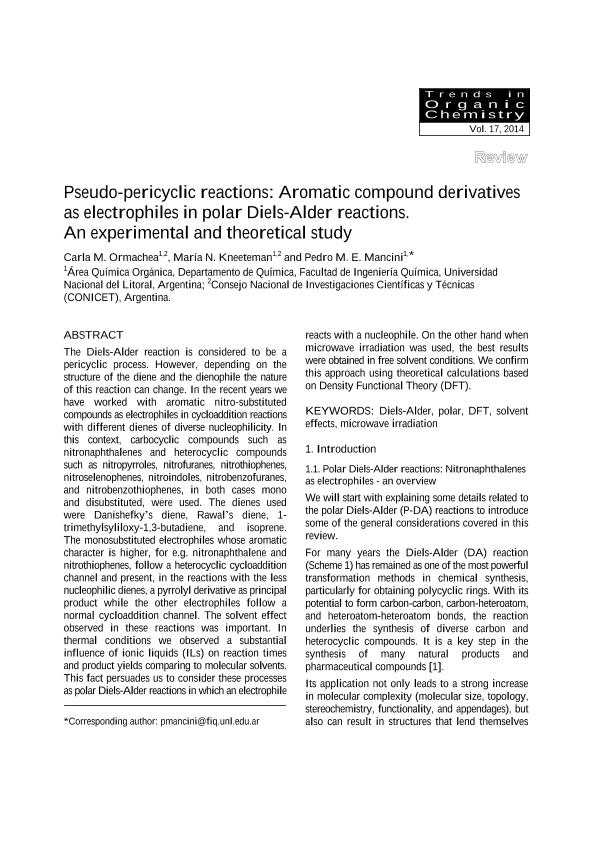Mostrar el registro sencillo del ítem
dc.contributor.author
Ormachea, Carla

dc.contributor.author
Kneeteman, Maria Nelida

dc.contributor.author
Mancini, Pedro
dc.date.available
2017-04-26T19:00:58Z
dc.date.issued
2014-11
dc.identifier.citation
Ormachea, Carla; Kneeteman, Maria Nelida; Mancini, Pedro; Pseudo-Pericyclic Reactions: Aromatic Compound Derivatives as Electrophiles in Polar Diels-Alder Reactions. An Experimental and Theoretical Study; The Research Trends Editorial; Trends in Organic Chemistry; 17; 11-2014; 73-91
dc.identifier.issn
0972-4362
dc.identifier.uri
http://hdl.handle.net/11336/15753
dc.description.abstract
The Diels-Alder reaction is considered a pericyclic procces. However, depending of the structure of the diene and the dienophile the nature of this reaction can change. In the last years we have worked with aromatic nitro substituted compounds as electrophile in cycloaddition reactions with different dienes of diverse nucleophilicity. In that direction, it was used carbocyclic -nitronaphthalenes- and heterocyclic -nitropyrroles, nitrofuranes, nitrothiophenes, nitroselenophenes, nitroindoles, nitrobenzofuranes, and nitrobenzothiophnes-, in both cases mono and disubstituted. The dienes used were Danishefkys´diene, Rawals?diene, 1-trimethylsyliloxy-1,3-butadiene, and isoprene. Those monosubstituted electrophiles which aromatic character is higher -e.g. nitronaphthalene and nitrothiophenes- follow an heterocyclic cycloaddition channel and offer in its rections with the less nucleophilic dienes a pyrrolyl derivative as principal product, instead the others electrophiles follow a normal cycloaddition channel. In all these reactions the solvent effect was important. In thermal conditions we observed a great influence of ionic liquids (ILs) respect to the molecular solvents.This fact persuade us to consider these processes as polar Diels-Alder reactions in which and in a simple interpretation react an electrophile with a nucleophile. On the other hand when it was used microwave irradiation the best resold was obtained in free solvent conditions. We confirm this approach using theoretical calculations based on Density Functional Theory (DFT).
dc.format
application/pdf
dc.language.iso
eng
dc.publisher
The Research Trends Editorial
dc.rights
info:eu-repo/semantics/openAccess
dc.rights.uri
https://creativecommons.org/licenses/by-nc-sa/2.5/ar/
dc.subject
Diels-Alder
dc.subject
Dft
dc.subject
Solvent Effects
dc.subject
Microwave Irradiation
dc.subject
Polar
dc.subject.classification
Química Orgánica

dc.subject.classification
Ciencias Químicas

dc.subject.classification
CIENCIAS NATURALES Y EXACTAS

dc.title
Pseudo-Pericyclic Reactions: Aromatic Compound Derivatives as Electrophiles in Polar Diels-Alder Reactions. An Experimental and Theoretical Study
dc.type
info:eu-repo/semantics/article
dc.type
info:ar-repo/semantics/artículo
dc.type
info:eu-repo/semantics/publishedVersion
dc.date.updated
2017-04-17T19:27:00Z
dc.journal.volume
17
dc.journal.pagination
73-91
dc.journal.pais
India

dc.description.fil
Fil: Ormachea, Carla. Universidad Nacional del Litoral. Facultad de Ingeniería Química. Departamento de Química Orgánica; Argentina. Consejo Nacional de Investigaciones Científicas y Técnicas. Centro Científico Tecnológico Conicet - Santa Fe; Argentina
dc.description.fil
Fil: Kneeteman, Maria Nelida. Universidad Nacional del Litoral. Facultad de Ingeniería Química. Departamento de Química Orgánica; Argentina. Consejo Nacional de Investigaciones Científicas y Técnicas. Centro Científico Tecnológico Conicet - Santa Fe; Argentina
dc.description.fil
Fil: Mancini, Pedro. Universidad Nacional del Litoral. Facultad de Ingeniería Química. Departamento de Química Orgánica; Argentina
dc.journal.title
Trends in Organic Chemistry
dc.relation.alternativeid
info:eu-repo/semantics/altIdentifier/url/http://www.researchtrends.net/tia/abstract.asp?in=0&vn=17&tid=14&aid=5717&pub=2014&type=
Archivos asociados
